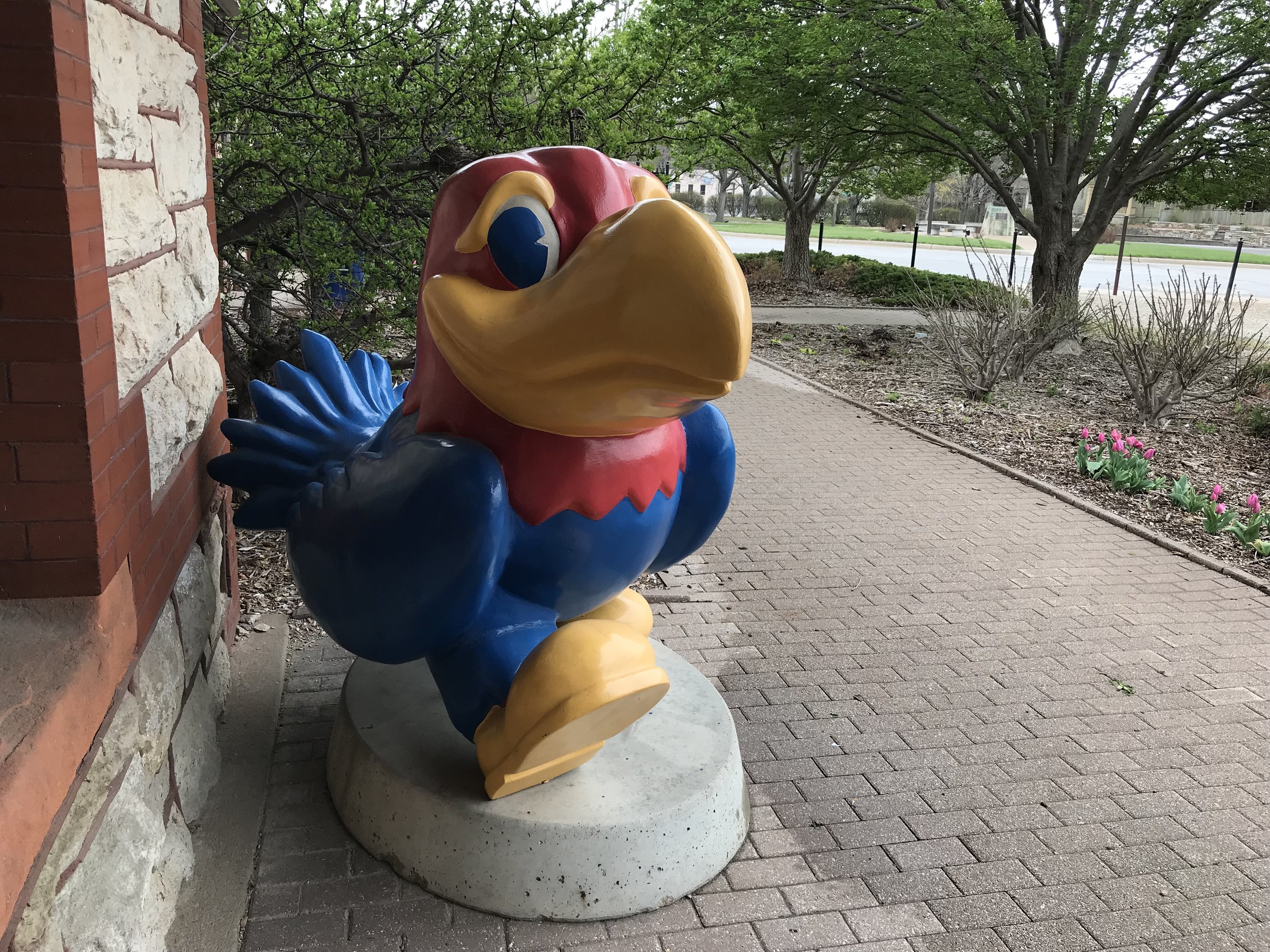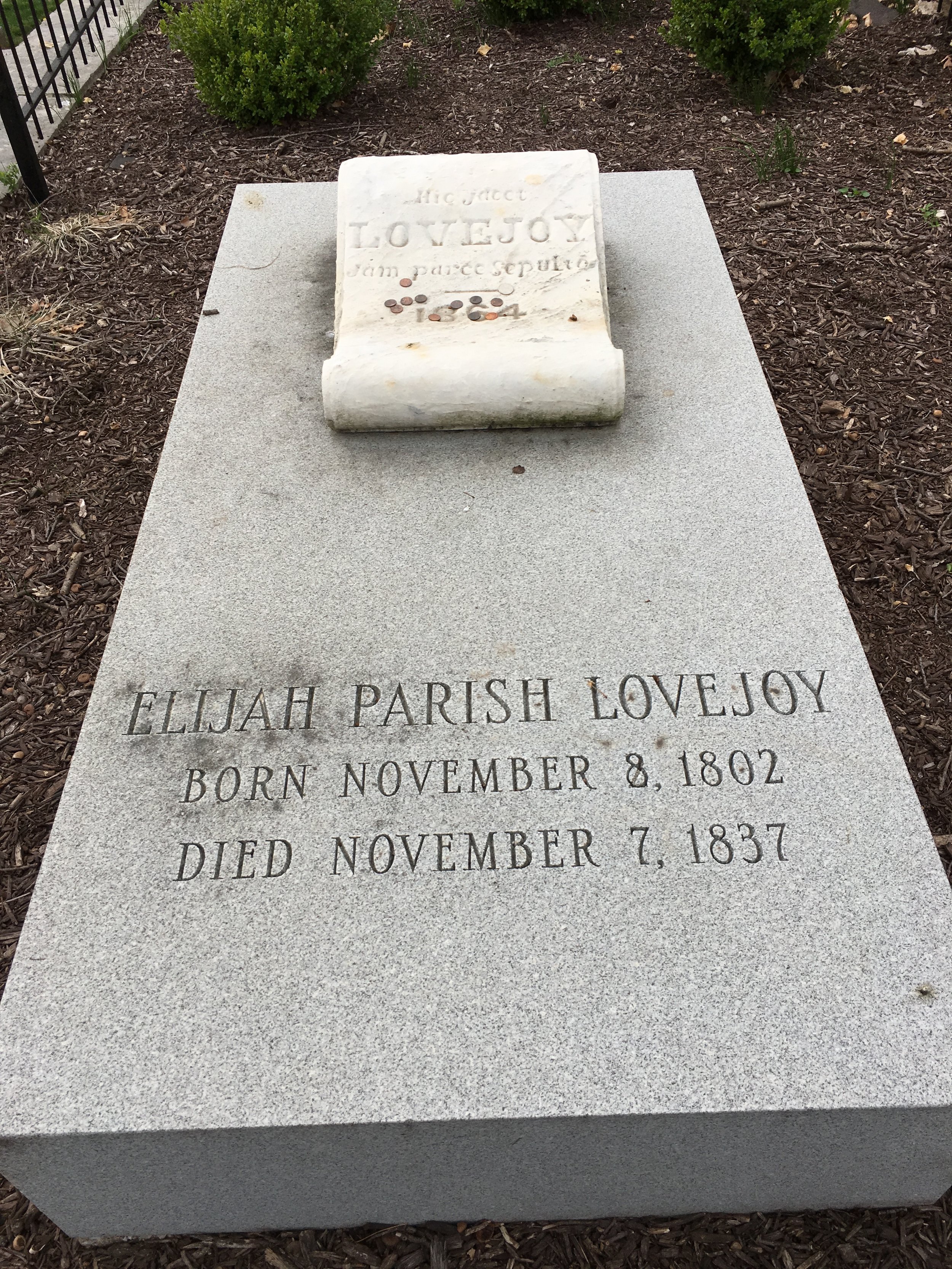Jayhawkers, Bushwhackers and a First Amendment martyr
Finding the Civil War in the Midwest
By Rick Holmes
May 11, 2018
Alton, Ill. – In the Deep South, you’re immersed in the Civil War. Everywhere you turn, there’s a Confederate statue looking at you, a highway named for a Secessionist general. In the Midwest, you have to look for it a little, but it’s there.
At a visitor center in Kansas, I look over at the colorful plastic bird welcoming tourists to the home of the University of Kansas’ famed Jayhawks. “What is a Jayhawk anyway?” I ask at the desk.
The term dates back to the days of “Bleeding Kansas,” a volunteer explains. The 1854 Kansas-Nebraska Act gave territories the right to decide on their own whether to enter the Union as free or slave states. That set off a contest between Free-Staters – later known as “Jayhawkers” – and pro-slavery forces that became known as “Border Ruffians” and “Bushwhackers.” The issue of Kansas’ future was waged with politically-inspired immigration, election fraud and murder.
The New England Emigrant Aid Company founded Lawrence, in eastern Kansas, encouraging abolitionists to settle there. Citizens of Missouri, a slave state, crossed the border to vote for slavery in Kansas. Things went from tense to deadly. In 1856, a gang of Missourians raided Lawrence, burning the Free State Hotel, sacking homes and businesses, and destroying two newspaper offices. Newspapers took sides back then, and publishers who opposed slavery were targeted by those who supported it.
In retaliation, fiery abolitionist John Brown led his own band to nearby Pottawatamie, where he killed five pro-slavery sympathizers. Hacked them to pieces.
The fighting went on for years, and it got more intense after the Civil War began. In the East, the war was fought by armies commanded by gentleman generals who knew each other from West Point. In Bleeding Kansas it was fought by terrorists and guerillas who drew no distinction between combatants and civilians. It was more personal. In 1863, William Quantrill led 400 Missourians back to Lawrence armed with a list of targets. By the time they left, 150 men and boys had been massacred.
You see a lot of Jayhawks in Kansas today, because it’s the mascot of University of Kansas sports teams. You’ve got to look for historical markers to see Bleeding Kansas.
You can find signs of America’s great divide on Missouri’s other border as well. In the shadow of St. Louis’ mighty Gateway Arch, I stumbled upon Dred Scott Way, running in front of the courthouse where the slave demanded – and nearly won – his freedom. Scott’s district court victory was reversed by the U.S. Supreme Court, which held that no one descended from slaves could ever be a citizen.
Here in Alton, a few miles up the Mississippi from St. Louis, there’s not much left of the prison that used to hold Confederate prisoners. Another place, dubbed “Smallpox Island,” where hundreds of quarantined prisoners died, has been reclaimed by the Mississippi. Alton’s stations of the Underground Railroad are almost as anonymous today as when they sheltered countless escaped slaves running to freedom.
But this is the land of Lincoln, where his many visits are carefully chronicled. Alton has a downtown park on the site where Abraham Lincoln and Stephen Douglas held the the last of their famous debates.
The tallest monument in Alton – indeed, in the entire state – honors a far less familiar figure.
Elijah Parish Lovejoy was a Presbyterian minister and a newspaper editor whose editorials opposing slavery weren’t welcome in pro-slavery St. Louis. An angry mob raided Lovejoy’s office and threw his printing press into the Mississippi. The same thing happened to his second press, and his third.
Lovejoy moved his operations to Alton, where he thought he’d be safer. He wasn’t: Alton was home to slave catchers and southern sympathizers as well as abolitionists, some of whom argued that freedom of the press did not protect criticism of slavery. They threw his fourth press into the river; he pulled it out and they threw it in again. Lovejoy was defending his fifth press against another angry mob when he was shot and killed. The mob broke his printing press into pieces and threw them into the Mississippi.
Lovejoy was later called a martyr to the First Amendment and the first casualty of the Civil War, but he was dead 60 years before the townspeople – “Alton that slew him and Alton that defended him” -- erected a memorial in his name.
All of this happened a long time ago, of course. But when mobs take their differences to the street, when leaders declare the press to be “the enemy of the people,” we ought to remember where political polarization can lead. The historical markers we casually ignore, the ones that tell old stories in granite and bronze, aren’t just relics. They can be warnings as well.
Rick Holmes can be reached at rick@rickholmes.net. You can follow his journey at www.rickholmes.net. Like him on Facebook at Holmes & Co, on follow him on Twitter @HolmesAndCo.



